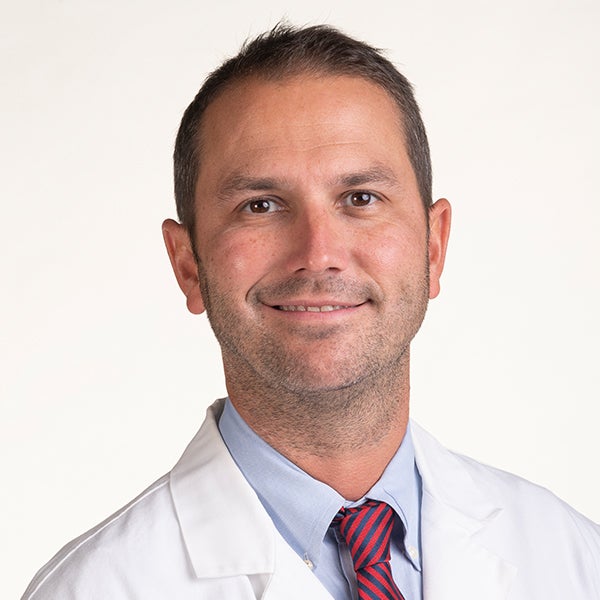A ‘pacemaker for your spine’ might be an option.
Back pain is one of the most common causes of disability and loss of quality of life. For most patients, traditional types of treatment such as physical therapy, chiropractic treatment and surgery are successful. But for some patients, back pain and pain that radiates down the leg (sciatica) do not respond well to these treatments. In these cases, a technology known as spinal cord stimulation may provide relief.
What is spinal cord stimulation?
Spinal cord stimulation (SCS) uses electrical signals to modify nerve activity. SCS can be thought of as a pacemaker for the spinal cord. A battery-powered electric pulse generator about the size of a deck of cards is placed under the skin of the lower back, typically over the buttock below the waistline. A small electrode array is inserted into the spinal canal through a special needle to deliver small pulses of electrical current to the spinal cord.
Is a spinal cord stimulator right for me?
In general, spinal cord stimulators are used to treat patients with low back pain and leg pain lasting more than 6 months (chronic pain) that has not improved with multiple conservative treatments. Conservative treatment usually includes, but is not limited to, physical therapy, chiropractic treatment, medications, spinal injections, and sometimes surgery. A thorough history, physical examination, and neuroimaging examination is necessary before we can consider spinal stimulation. If a neurological deficit is present – for example, muscle weakness or foot drop – spinal stimulation is probably not appropriate. If there is evidence of underlying nerve compression or spinal instability, treatment is usually focused on correcting the underlying anatomic problem instead of placing a stimulator.
If a patient has ongoing leg and/or back pain that has not improved with conservative treatment and they are not a candidate for traditional surgical treatment, they may be a good candidate for a trial of spinal cord stimulation.
What is an SCS trial?
Prior to placing a permanent implant, the patient will undergo a stimulation trial. Small electrode wires are placed into the spinal canal through a needle under local anesthesia. The position of the wires is confirmed with x-ray. The wires are connected to an external pulse generator that the patient wears outside the body. The trial allows the patient to experience the effects of stimulation for 2-7 days to determine if the implant would be beneficial.
If the patient experiences a greater than 50% reduction in pain and does not have any unacceptable side effects, they will be offered a permanent implant. The permanent spinal cord stimulator system, including the battery pack and electrode wires, is implanted under general anesthesia in an operating room. Unlike the trial system, the permanent system is completely under the skin.
Once an SCS is implanted, how does it work?
The exact reason SCS works is still being studied. It appears that it blocks pain signals with smaller signals caused by electrical stimulation – similar to the way a controlled burn can block a wildfire. Using a remote, the patient can raise and lower the level of stimulation based on their level of pain. Sometimes the patient may feel a tingling sensation at higher output levels, but generally, stimulation is painless. The battery life of newer, rechargeable systems is 10 years or longer.
Are new treatment options on the way?
A new form of spinal stimulation has emerged recently called dorsal root ganglion (DRG) stimulation. Rather than targeting the spinal cord itself, DRG stimulation targets individual spinal nerves that may be contributing to a patient’s pain. Over time, nerves that have been constantly inundated with pain signals from the skin and joints become hyper-excitable and will fire at lower thresholds than would a normal nerve. By placing an electrode over the relay center for the spinal nerve (the DRG), these abnormal signals can theoretically be blocked, leading to a significant reduction in pain. The principal role for DRG stimulation is in complex regional pain syndrome and causalgia.
What is complex regional pain syndrome (CRPS)?
CRPS, formerly known as Reflex Sympathetic Dystrophy (RSD), is a condition where sensory nerves become hyper-excitable for reasons that are not well understood. By definition, CRPS type 1 occurs without an injury or other known cause. The patient will experience pain in the affected arm or leg, hypersensitivity to touch, and changes in the limb such as atrophy (wasting), swelling, discoloration, and hair loss. In patients with RSD, the hyper-excitable nerves mistake mild sensory signals such as a light touch or a breeze as a burning sensation or severe pain. DRG stimulation may be beneficial in these cases.
What is causalgia?
Causalgia is similar to CRPS type 1 but occurs after a triggering event such as trauma. Causalgia can occur after hernia repair surgery, obstetric and gynecological procedures such as hysterectomy, limb amputation, genito-urinary surgery involving the penis or testicles, and after orthopedic procedures such as hip and knee replacement or foot and ankle surgery. As is true with low back pain, a treatable anatomical cause must be ruled out by the primary surgeon prior to considering stimulation. If a particular nerve can be identified as a pain generator, DRG may be helpful.
What are the risks?
The major risk of SCS is infection. A great deal of care and attention is taken to prevent infection. If the system becomes infected, it must be removed. Other risks include bleeding into the spinal canal, leakage of cerebrospinal fluid, failure to get the same pain relief as experienced in the trial, and pain over the battery site. Careful patient selection is critical to reduce these risks. As with any surgical procedure, there is a very small risk of unexpected bad things happening such as coma, stroke, paralysis, and death.
I want to learn more about SCS and DRG. Who do I talk to?
If you have a pain management physician, ask your doctor if you may be a candidate for spinal cord stimulation or dorsal root ganglion stimulation. If you do not have a pain management specialist, contact us at Georgia Neurological Surgery and Comprehensive Spine, and we can help guide you to the right specialist to get your questions answered.

About Dr. Woodall
Dr. Woodall is a fellowship-trained, board-certified neurosurgeon with particular expertise in surgical treatment of complex and challenging neurosurgical problems, including brain aneurysms, brain and spinal blood vessel malformations (AVMs), and difficult-to-reach tumors. He is St. Mary’s medical director of neurosciences and an associate clinical professor of neurosurgery at the Augusta University/UGA Medical Partnership in Athens.
Dr. Woodall received his bachelor’s degree cum laude from the University of Georgia and his medical degree from Mercer University School of Medicine. He then completed a seven-year neurological surgery training program at the Medical College of Georgia, followed by an optional additional year of training in cerebrovascular and skull-base surgery at the world-renowned Barrow Neurological Institute in Phoenix, Arizona.

